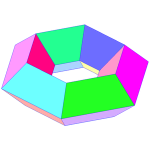
Nearly half of all blog posts start with "Soon this blog will be full of content" and the other half with "it has been incredibly silent, soon I will post a lot". This post is of the second type, but I apologize by linking to what has kept me from writing here:
Extended abstract of my diploma thesis.
While the diploma thesis is in german, the abstract is in english and only 9 pages long, without any proofs. The diploma thesis is now available here (updated on 2011-08-09).
As a teaser, here is the abstract of the abstract:
In classical covering space theory we have an isomorphism of the fundamental group with the fibre of the universal cover over the basepoint. Covering spaces of topological groups are group extensions, but not every group extension is a covering space. Perfect groups admit a universal central extension and the kernel of this extension is also called fundamental group. For simply connected Chevalley-groups over a perfect field, this fundamental group, classically called second unstable K-Theory, is exactly the fundamental group of a simplicial resolution. The loops are described explicitly by matrices.


